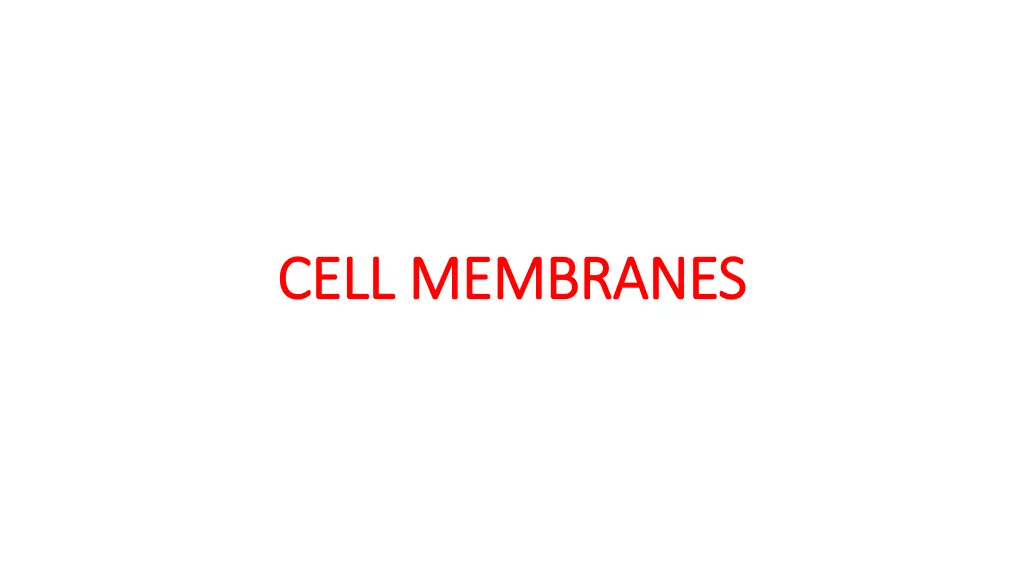
Cell Membrane Functions and Protein Structure
Explore the essential functions of cell membranes, including separating the cell's interior from its environment, defining internal compartments, and regulating molecule transport. Learn about integral and peripheral membrane proteins and the selective permeability of biological membranes. Discover how small molecules are transported across cell membranes through passive diffusion.
Uploaded on | 2 Views
Download Presentation

Please find below an Image/Link to download the presentation.
The content on the website is provided AS IS for your information and personal use only. It may not be sold, licensed, or shared on other websites without obtaining consent from the author. If you encounter any issues during the download, it is possible that the publisher has removed the file from their server.
You are allowed to download the files provided on this website for personal or commercial use, subject to the condition that they are used lawfully. All files are the property of their respective owners.
The content on the website is provided AS IS for your information and personal use only. It may not be sold, licensed, or shared on other websites without obtaining consent from the author.
E N D
Presentation Transcript
CELL MEMBRANES CELL MEMBRANES
Functions: Separate the interior of the cell from its environment. Define the internal compartments of eukaryotic cells, including the nucleus and cytoplasmic organelles. Membrane proteins are responsible for many specialized functions; some act as receptors that allow the cell to respond to external signals. some are responsible for the selective transport of molecules across the membrane. Others, participate in electron transport and oxidative phosphorylation. Membrane proteins control the interactions between cells of multicellular organisms.
A. Integral membrane proteins: They are embedded directly within the lipid bilayer. Most integral membrane proteins (called transmembrane proteins) span the lipid bilayer, with portions exposed on both sides of the membrane. The membrane-spanning portions of these proteins are usually -helical regions of 20 to 25 nonpolar amino acids. The hydrophobic side chains of these amino acids interact with the fatty acid chains of membrane lipids, and the formation of helix neutralizes the polar character of the peptide bonds.
Like the phospholipids, transmembrane proteins are amphipathic molecules, with their hydrophilic portions exposed to the aqueous environment on both sides of the membrane. Some transmembrane proteins span the membrane only once; others have multiple membrane-spanning regions. Most transmembrane proteins of eukaryotic plasma membranes have been modified by the addition of carbohydrates, which are exposed on the surface of the cell and may participate in cell-cell interactions. B. Peripheral membrane proteins are not inserted into the lipid bilayer but are associated with the membrane indirectly, generally by interactions with integral membrane proteins.
Transport across Cell Membranes The selective permeability of biological membranes to small molecules allows the cell to control and maintain its internal composition. Only small uncharged molecules can diffuse freely through phospholipid bilayers. Small nonpolar molecules, such as 0 2 and C02, are soluble in the lipid bilayer and therefore can readily cross cell membranes. Small uncharged polar molecules, such as H20, also can diffuse through membranes, but larger uncharged polar molecules, such as glucose, cannot. Charged molecules, such as ions, are unable to diffuse through a phospholipid bilayer regardless of size; even H+ ions cannot cross a lipid bilayer by free diffusion.
Transport of small molecules: Passive Diffusion
Although ions and most polar molecules cannot diffuse across a lipid bilayer, many such molecules (such as glucose) are able to cross cell membranes. These molecules pass across membranes via the action of specific transmembrane proteins, which act as transporters. Such transport proteins determine the selective permeability of cell membranes and thus play a critical role in membrane function. They contain multiple membrane-spanning regions that form a passage through the lipid bilayer, allowing polar or charged molecules to cross the membrane through a protein pore without interacting with the hydrophobic fatty acid chains of the membrane phospholipids.
There are two general classes of membrane transport proteins. A- Channel proteinsform open pores through the membrane, allowing the free passage of any molecule of the appropriate size. Carrier proteins selectively bind and transport specific small molecules, such as glucose. Rather than forming open channels, carrier proteins act like enzymes to facilitate the passage of specific molecules across membranes. In p articular, carrier proteins bind specific molecules and then undergo conformational changes that open channels through which the molecule to be transported can pass across the membrane and be released on the other side.
B- Ion channels: allow the passage of inorganic ions such as Na+, K+, Ca2+, and CI- across the plasma membrane. Once open, channel proteins form small pores through which ions of the appropriate size and charge can cross the membrane by free diffusion. The pores formed by these channel proteins are not permanently open; rather, they can be selectively opened and closed in response to extracellular signals, allowing the cell to control the movement of ions across the membrane. Such regulated ion channels have been particularly well studied in nerve and muscle cells, where they mediate the transmission of electrochemical signals.
Passive Transport: Molecules transported by either channel or carrier proteins cross membranes in the energetically favorable direction, as determined by concentration and electrochemical gradients- a process known as passive transport. Active Transport: Carrier proteins also provide a mechanism through which the energy changes associated with transporting molecules across a membrane For example, molecules can be transported in an energetically unfavorable direction across a membrane (e.g., against a concentration gradient) if their transport in that direction is coupled to ATP hydrolysis as a source of energy-a process called active transport. Membrane proteins can thus use the free energy stored as ATP to control the internal composition of the cell.
